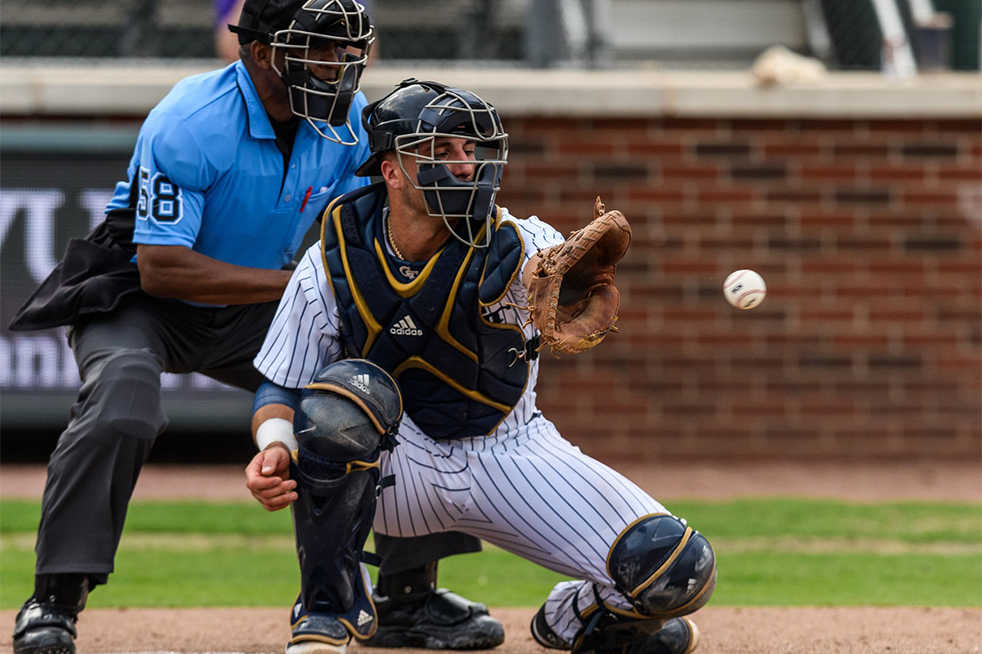Last Monday, the San Francisco Giants announced that they had drafted Tech catcher Joey Bart with the second overall pick in the MLB Amateur draft. Bart, ranking among the finest athletic talent to ever come out of Tech, is expected to sign with the Giants for upwards of several million dollars — the no. 2 overall pick from the 2017 draft, Hunter Greene, signed with the Cincinnati Reds for $7.23 million last year — and joined the Giants minor league system as early as this summer.
Bart’s selection in the MLB draft ties him for the highest ever selection of a Tech athlete in a professional sports draft. Among Yellow Jackets, only Calvin Johnson (drafted by the Detroit Lions in the 2007 NFL draft) and Kenny Anderson (drafted by the New Jersey Nets in the 1991 NBA draft) were ever drafted second overall in a professional sports before Bart. Until now, Tech’s highest ever selection in the MLB draft was that of Kevin Brown, who was drafted fourth overall by the Texas Rangers in 1986.
No Tech athlete has been drafted first overall in any draft, though speculation over the health of the eventual No. 1 overall pick, Auburn pitcher Casey Mize, led to speculation that Bart might reach that distinction. Still, on draft night, the Detroit Tigers opted to take Mize over Bart, leaving Bart to the Giants. Bart’s selection in the draft should come as little surprise to those following Tech baseball — since arriving at Tech, Bart has developed into one of the biggest offensive threats in the nation. In 57 games this season, Bart batted .359 (1st in the ACC), reached base at a .471 clip (3rd), and slugged .632 (2nd). Evaluators have described Bart as having superb power with excellent contact ability, and Bart is projected by scouts as having a middle-of-the-order bat, a rarity at the position of catcher.
But Bart is a dual threat – his defensive abilities at catchers have drawn raves from scouts. Adam McInturff, scouting director for 2080Baseball.com, clocked Bart’s pop time (the time it takes a catcher to receive a pitch, transition the ball to his throwing hand, and release the ball in throwing to second base to catch a runner attempting to steal) at 1.85-1.90, a figure bested by only one current MLB catcher, J.T. Realmuto of the Miami Marlins. In addition, FanGraphs describes Bart as a hard worker behind the plate: “He also does advance work for every game, calls area scouts for gameplan input, and is possibly the only catcher at a major program that calls his own games. Scouts rave about his makeup.”
As Bart is already a highly developed defensive catcher with his hit tool not too far behind, some have speculated that Bart may debut in the majors as soon as next season. The Giants might not feel rushed to do so, however – Giants catcher Buster Posey already has the position locked down as one of the best catchers in the MLB.
Posey, the catcher most recently drafted by the Giants in the first round, is well on pace for a HOF caliber career and has set the standard at a position usually starved for offense, having collected multiple Silver Slugger awards in addition to his 2012 NL MVP award.
With Bart in their system, the Giants appear poised to replace excellence with excellence should Posey move to first base as many elite-hitting catchers do late in their careers.
Bart joins a long line of elite Tech catchers drafted early. Matt Wieters was taken fifth overall by the Baltimore Orioles in 2007, and Jason Varitek was drafted by the Seattle Mariners in the first round of the 1994 draft. Both catchers had superb careers: both Varitek and Wieters receiving multiple All-Star Game nominations, and Varitek was an instrumental part of the Boston Red Sox’s World-Series-winning teams in 2004 and 2007.
Bart was not the only Tech player taken in this year’s draft. Tech’s consistent 2B, Wade Bailey, was drafted in the 33rd round by the Los Angeles Angels, and Tech signees Logan Simmons, Reese Olson, and Luke Bartnicki all got the call on draft day. It’s another mark in the tradition of excellence from Tech’s baseball program, which has produced more than 60 MLB players, including 8 players active in the MLB as of 2018.
